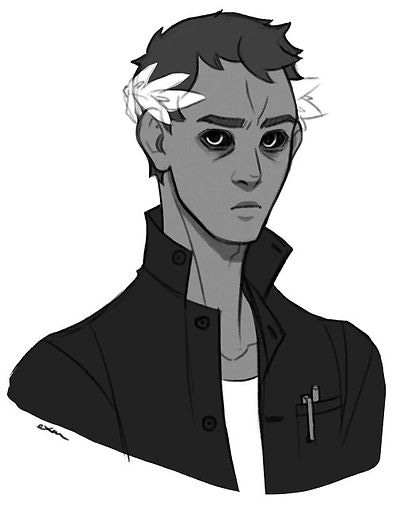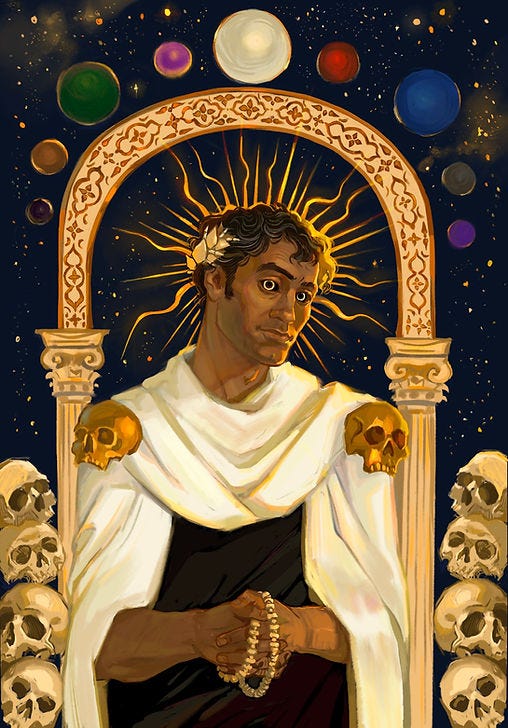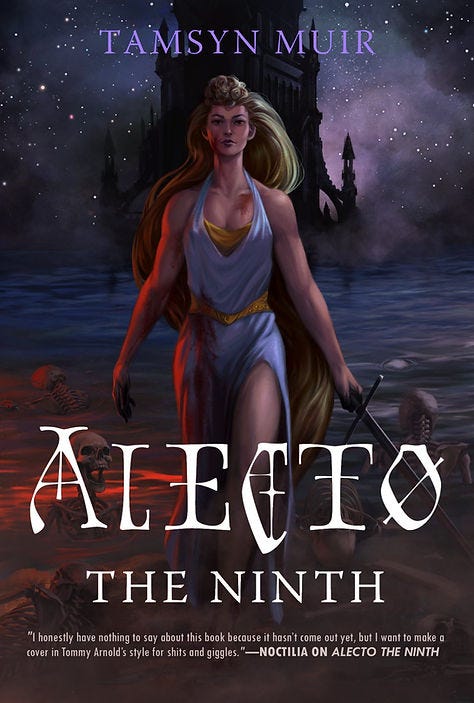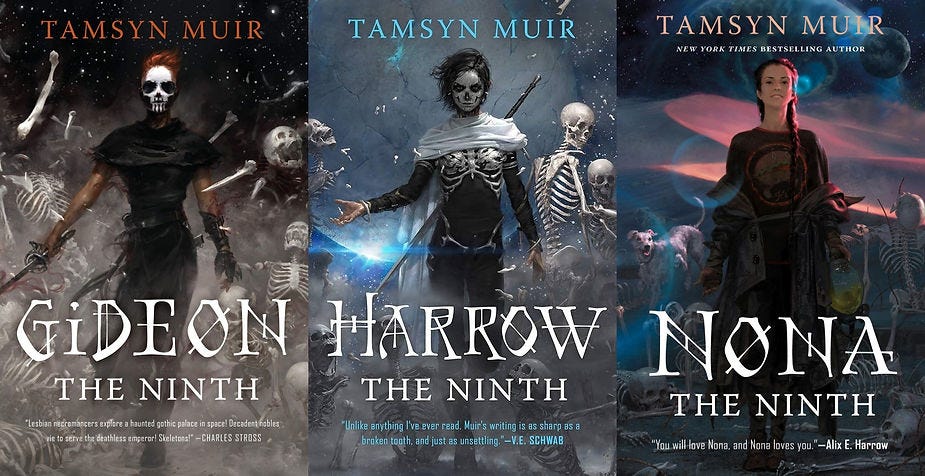The Locked Tomb: Dying Earth and Her Broken God
The secret climate crisis behind our favourite lesbian necromancers in space
Welcome to the Bone Zone
It's hard to believe that Gideon the Ninth, the first book in New Zealander author Tamsyn Muir's The Locked Tomb series, is only five years old. Even more so that I've waited so long to write in depth about this queer, gory, mysterious masterpiece of speculative fiction (though I did sneak a mention in my riffle through great lesbian characters).
These books might look or sound strange at first, but trust me that you don't know the half of it. This is Mean Girls meets The Substance meets Evil Dead meets Sherlock Holmes plus about a dozen more elements, sprinkled in choice cuts of millennial internet humour and a God who has spent his 10,000 year reign perfecting his dad jokes.
But beyond all of that, I find the very experience of reading these books to be unique. With Harrow and Nona especially, but also Gideon to a lesser extent, my first read just was a confused thrill ride. Now I love being dropped into a bizarre world with the freedom to figure things out for myself, so it was great fun trying (and utterly failing) to predict where Muir was going, but I know that's not true for everyone.
The great news is that my second read of the series was completely different, with tons of foreshadowing nuance and detail popping out that I must have glazed over the first time around. So, hey, consider reading these great books; Gideon the Ninth available free as an audiobook with either your Audible or Spotify subscription! I won't be covering any major plot spoilers today, but continue at your own risk if you want to experience this for yourself.
John Gaius, His Celestial Kindliness, the First Reborn, the Necrolord Prime, King of the Nine Renewals, Emperor of the Nine Houses
Meet God; you can call him John. He created the universe as we understand it (for the first two books), he keeps the sun shining, he has a lot of unhealthy habits, has the blood of billions on his hands and, as previously established, he loves dad jokes. Also, as he shares through dream sequences in Nona the Ninth, he was once just a well-meaning scientist.

(The B-plot of the third book might sound like a strange place to begin exploring this world, but this is where we finally get the history of Muir's world – and a peek at one of the subtle message of the series.)
The Earth is dying and different ideas are being raised to save humanity. John and his team are working on a cryogenics-based solution to save the most lives possible and, crucially, try to let the Earth heal once those people are packed off for the stars. It isn't made expressly clear in the text, but I think it's fair to say that John's virtuous beliefs and attitude are why the dying spirit of the Earth "picked [John] to change" [Nona, p. 410].
All magic in this world is based on the energies of life and death, so planets – and especially Earth, teeming with the cycles of life – are sources of incredible power. The Earth entwines her soul with John's and he quickly finds he has the power of necromancy; he experiments animating the bodies he was using to test his cryogenics technology before expanding his sights further and further afield.

In the meantime, and despite John’s best efforts to bring attention to the cryogenics plan, a group of trillionaires have won out with their plan to evacuate the population with multiple waves of faster-than-light ships. It smells fishy right up until it’s revealed that yes, they’re actually just getting themselves out of dodge and leaving the rest of humanity, and Earth, to die. (As a brief side note, I started Adrian Tchaikovsky’s Firewalkers immediately after my reread and it was amusing to see a very similar depiction of events.)
Utterly frustrated and enraged, John makes it his goal to stop their escape. Negotiation fails him, and he ends up draining every life in the solar system in an attempt to catch the departing ships. A little later he begins the Resurrection by forging a human body for undead Earth (named Alecto) and the world of The Locked Tomb is born.

John's story is the tragedy of righteous fury overshadowing noble purpose; vengeance eclipsing recovery. When one of his companions raises the idea of using his newfound powers to heal specific damage to the Earth, he ignores her in favour of learning more about his control over life and death [Nona, p. 397]. He was never perfect, but his backstory demonstrates that it didn't take much of power's corrupting touch to reveal the cracks in his character.
Of course part of what makes Jod (a fan name amalgamating John + God) such a chilling, complex, fascinating character is that the entire universe of the series is built on his tragedy and his attempts to deal with its consequences. In future posts I'll discuss the rest of the incredibly compelling cast, whose entire lives have been shaped, either directly or through 10,000 years of reverberating cause-and-effect, by this terrifying and punny figure.
Hidden but Potent Moral
As I alluded to previously, Nona the Ninth can be an incredibly confusing read the first time around. Part of that, believe it or not, is that the climate crisis and Earth dying are never stated explicitly throughout this book. I certainly didn't see the connection until I started looking up explainer posts after reading, and I've seen multiple reviews by others who had no idea.
I wouldn't put it past Muir to just enjoy confusing readers for the sake of it, but I think she accomplished something more. Harrow the Ninth is well-nigh unintelligible until you discern the secret that shapes it. In the same way, you can read Nona and/or live on this planet just a little confused until you recognize the reality of global warming.
I'll be fascinated to see whether Muir makes this theme more prominent in Alecto the Ninth, though I might not recognize it either way at first. Would be nice to see it become more prominent in our own plotline, because for better or worse we don't have John to go for our throats. ('Cause he's a neck-romancer.)





